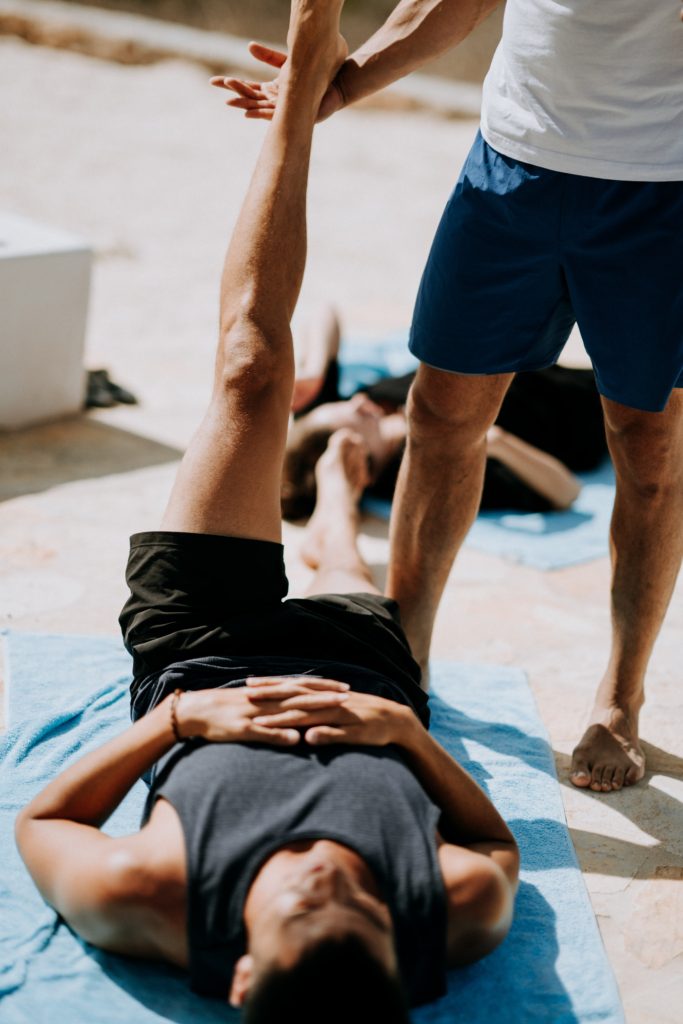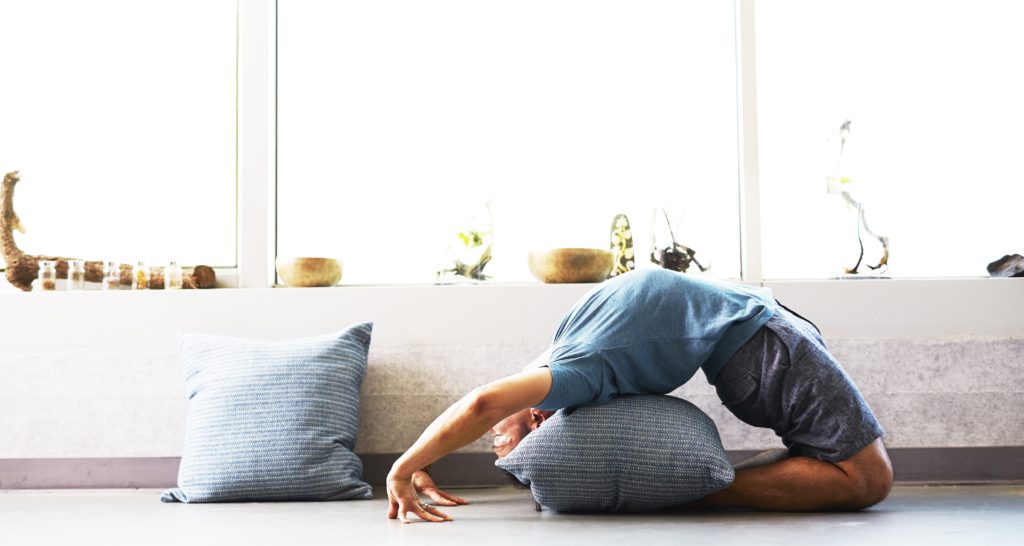Yoga can be off-putting at first for a lot of men, especially when so much about modern yoga seems to be geared towards women. Add to that the fact that Instagram is full of women in very bendy poses, and it’s little surprise that most men give it a wide berth.
However, the fact of the matter is that it isn’t the quasi-gymnastic manoeuvres that fill our timelines that provide yoga’s many benefits; it’s actually the more basic yoga poses (asanas) that help men become flexible, strong and confident.
So don’t worry if you can’t get your feet behind your head, or do the splits, there is so much more to yoga than that. To help you get started, here are 11 tips for men getting started with yoga.
1. Be Patient
Yoga will feel completely new to you and to your body. It will work on muscles that you have probably never worked on before and may not have even known existed, like the subscapularis muscles and piriformis.
The key to getting started with yoga and sticking to it is to be patient. When it comes to working out, this can be problematic for many men because of that thing called ego. There’s also the competition aspect that is just a natural part of being a man. These must be pushed aside when starting yoga, and also when continuing with it.
Yoga is no place for ego, and it’s definitely not a competition. Be humble and do what you can, knowing that there is a light at the end of the tunnel.

2. Find teachers you click with
Remember the subjects you loved most at school? How many of those were because you liked the teacher or clicked well with their teaching style? Well, it’s the same in yoga. Especially when you’re first starting out, your learning curve will be quite steep, so you want to be receiving lessons in a way that works for you.
Many yoga studios offer introductory discount offers for newbies, allowing you to not only try a range of yoga styles, but also teachers too. Take advantage of this and work out what kind of teaching style works best for you.
When I was first starting out I wanted a teacher that demonstrated everything in relatively slow motion, and with patience and empathy. These days I like to flow a lot harder and prefer teachers that push me out of my comfort zone, getting hands-on and more forceful to correct my form.
3. Focus on Yourself
When in a yoga class, don’t worry about what others are doing; focus on yourself. It’s important to remember that no two bodies are alike. Everyone has different strengths and weaknesses, and everybody has different levels of flexibility. If you concentrate on what everyone else is doing, AND compare yourself to them, you will get nowhere. In fact, you could actually hurt yourself by trying to do too much before your body (and mind) is ready.
Do what feels right for you and what works on your body. What works for you may not work for someone else, and vice versa. The more you focus on yourself, the more you will reap the benefits of yoga.
4. Know the difference between good pain and bad pain
When practicing yoga your body is going to be in poses and positions that it’s not used to. You will also be stretching muscles that you may have never stretched before. Sometimes you may think to yourself, “this really hurts.” But there’s a difference between good pain and bad pain.
Good pain is your body being uncomfortable, while feeling the stretch wherever the instructor tells you that you should feel it. Bad pain is your body telling you to stop. It’s much different than discomfort and it’s important to know the difference.
Listen to your body and what it’s trying to tell you.
5. Know your limits
Yoga isn’t about how flexible you are. Yes, the more flexible you get, the more you will realise all of the benefits of doing yoga. But that’s not the intention. Especially in the beginning. No one expects you to be able to touch your toes in the first class – although if you can, that’s great. Doing what you can is good enough. The more you practice, the more flexible you will become.
If you push yourself too much you can injure yourself, which will quickly bring your yoga practice to a halt.
Know your body’s limits, and focus on doing each pose properly, and breathing into it, rather than over-straining your body. Feel the stretch in the muscles that you’re supposed to and the muscle engagement in others.
6. Know your physiology
Not only know it, but work with what you have. Men are generally tight in the hips, hamstrings and chest. This is especially true for men that lift weights and play sport (hello football). Knowing this before you even start will help you to overcome your fears of doing yoga. These are typically the reasons why men often quit doing yoga or have a hard time starting in the first place.
What many men don’t realise is that yoga will help these things as well as others, including your posture and your endurance. Not to mention making your body more resistant to injuries. Again, everybody is different. Figure out your weak spots and work around them. Don’t get discouraged by things that have nothing to do with you personally and are just a man’s normal physiology.
7. Be comfortable
As in, be comfortable in your clothes.
It’s important to wear clothing that breathes well so that you feel comfortable. Don’t wear anything so tight that you’ll be tugging at it, or too loose that it will weigh you down, or flap in your face. The best things to wear for yoga are a snug t-shirt or vest top, and loose bottoms like swimming shorts.
You also want to wear clothing that breaths and can absorb moisture and sweat. Cotton is not great. Instead, opt for clothing that’s made of polyester, bamboo, polypropylene and tencel.
8. Try to build a connection between the mind and body
A unique thing about yoga is that it is often a slower form of exercise than a lot of men are used to. This means that you are able to slow down and really concentrate on your body and what it’s doing. It will help you to understand exactly what muscle is being built and how each movement works. This will then improve your mind, body connection. The intense focus that you will have on your body and each subtle movement will not only allow you to build outer strength, but inner strength as well.
Yoga will heighten your body awareness, improve the overall control of your body and increase mental performance.
9. Stay at the back of class
Many beginners like to be at the front of class where they can see what the teacher is doing. However, it’s best to stay at the back so that you can also see what others are doing. This will ensure that you’re not straining yourself or your neck to see what’s going on, and it will help you keep up. Plus, you won’t have any eyes on you.
Any good yoga teacher should still come to you wherever you are in the yoga studio to make sure that you are doing each pose properly. This will help ensure that you don’t injure yourself and you leave feeling challenged and refreshed.

10. Try different classes
There are many different types of yoga and some might mesh with you better than others. When you’re starting out try a variety of different styles to find the ones that best suit you, your goals and your personality. This could be anything from a slow Hatha class or an intense Ashtanga class.
Or maybe you want a class where you hold each pose for 5 minutes, using many props to help you along the way. It’s also a good idea to research the different styles of yoga beforehand so that you know what you’re getting yourself into before you even book yourself in.
Youtube is full of free videos of classes you can either flow along with or simply watch to give you an idea. Try Yoga with Tim, or Yoga with Adrienne for starters. These are no substitute for the hands-on attention and progress you’ll get from practicing with a real teacher, but they are great options for getting in some extra practice and familiarising yourself.
11. Don’t forget to breathe
Yes, this can be difficult when you’re doing things like trying to balance on one foot (tree pose) or laying on your stomach bending backwards (locust pose), but it’s important to always breathe. And not just regular breathing, breathing through your nose.
This is an important aspect of yoga because it activates the parasympathetic nervous system. When breathing through your nose, you’re teaching your mind and body how to stay calm and collected.
It requires you to breathe through your diaphragm – in yoga this is called Ujjayi breathing. Below is a video to help you learn this technique.
https://www.youtube.com/watch?v=zlEd6JEbABc
Don’t worry if you don’t breathe this way from the start, as long as you breathe. You never want to hold your breath while practicing yoga, as breath and movement are naturally linked. Plus, breathing deeply will help you sink deeper into every pose.
If you want to know the benefits of getting started with yoga I have also written this post with 10 major benefits of yoga for men.
Additional Yoga Resources
Elsewhere on ManBodySpirit.com we’ve created a range of yoga resources covering pretty much every question you might have. Take a look at:




